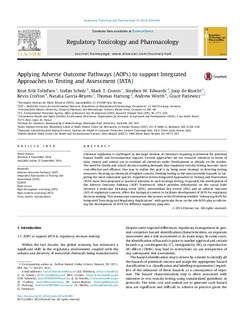| dc.contributor.author | Tollefsen, Knut Erik | |
| dc.contributor.author | Scholz, Stefan | |
| dc.contributor.author | Cronin, Mark T. | |
| dc.contributor.author | Edwards, Stephen W. | |
| dc.contributor.author | de Knecht, Joop | |
| dc.contributor.author | Crofton, Kevin | |
| dc.contributor.author | Garcia-Reyero, Natalia | |
| dc.contributor.author | Hartung, Thomas | |
| dc.contributor.author | Worth, Andrew | |
| dc.contributor.author | Patlewicz, Grace | |
| dc.date.accessioned | 2018-10-05T08:08:19Z | |
| dc.date.available | 2018-10-05T08:08:19Z | |
| dc.date.created | 2016-05-05T14:57:22Z | |
| dc.date.issued | 2014 | |
| dc.identifier.citation | Regulatory toxicology and pharmacology. 2014, 70 (3), 629-640. | nb_NO |
| dc.identifier.issn | 0273-2300 | |
| dc.identifier.uri | http://hdl.handle.net/11250/2566582 | |
| dc.description.abstract | Chemical regulation is challenged by the large number of chemicals requiring assessment for potential human health and environmental impacts. Current approaches are too resource intensive in terms of time, money and animal use to evaluate all chemicals under development or already on the market. The need for timely and robust decision making demands that regulatory toxicity testing becomes more cost-effective and efficient. One way to realize this goal is by being more strategic in directing testing resources; focusing on chemicals of highest concern, limiting testing to the most probable hazards, or targeting the most vulnerable species. Hypothesis driven Integrated Approaches to Testing and Assessment (IATA) have been proposed as practical solutions to such strategic testing. In parallel, the development of the Adverse Outcome Pathway (AOP) framework, which provides information on the causal links between a molecular initiating event (MIE), intermediate key events (KEs) and an adverse outcome (AO) of regulatory concern, offers the biological context to facilitate development of IATA for regulatory decision making. This manuscript summarizes discussions at the Workshop entitled “Advancing AOPs for Integrated Toxicology and Regulatory Applications” with particular focus on the role AOPs play in informing the development of IATA for different regulatory purposes. | nb_NO |
| dc.language.iso | eng | nb_NO |
| dc.publisher | Elsevier | nb_NO |
| dc.rights | Navngivelse 4.0 Internasjonal | * |
| dc.rights.uri | http://creativecommons.org/licenses/by/4.0/deed.no | * |
| dc.title | Applying Adverse Outcome Pathways (AOPs) to support Integrated Approaches to Testing and Assessment (IATA) | nb_NO |
| dc.type | Journal article | nb_NO |
| dc.type | Peer reviewed | nb_NO |
| dc.description.version | publishedVersion | nb_NO |
| dc.rights.holder | 2014 Elsevier Inc. All rights reserved. | nb_NO |
| dc.source.pagenumber | 629-640 | nb_NO |
| dc.source.volume | 70 | nb_NO |
| dc.source.journal | Regulatory toxicology and pharmacology | nb_NO |
| dc.source.issue | 3 | nb_NO |
| dc.identifier.doi | 10.1016/j.yrtph.2014.09.009 | |
| dc.identifier.cristin | 1354100 | |
| dc.relation.project | Norges forskningsråd: 221455 | nb_NO |
| cristin.unitcode | 7464,20,13,0 | |
| cristin.unitname | Økotoksikologi | |
| cristin.ispublished | true | |
| cristin.fulltext | original | |
| cristin.qualitycode | 1 | |

